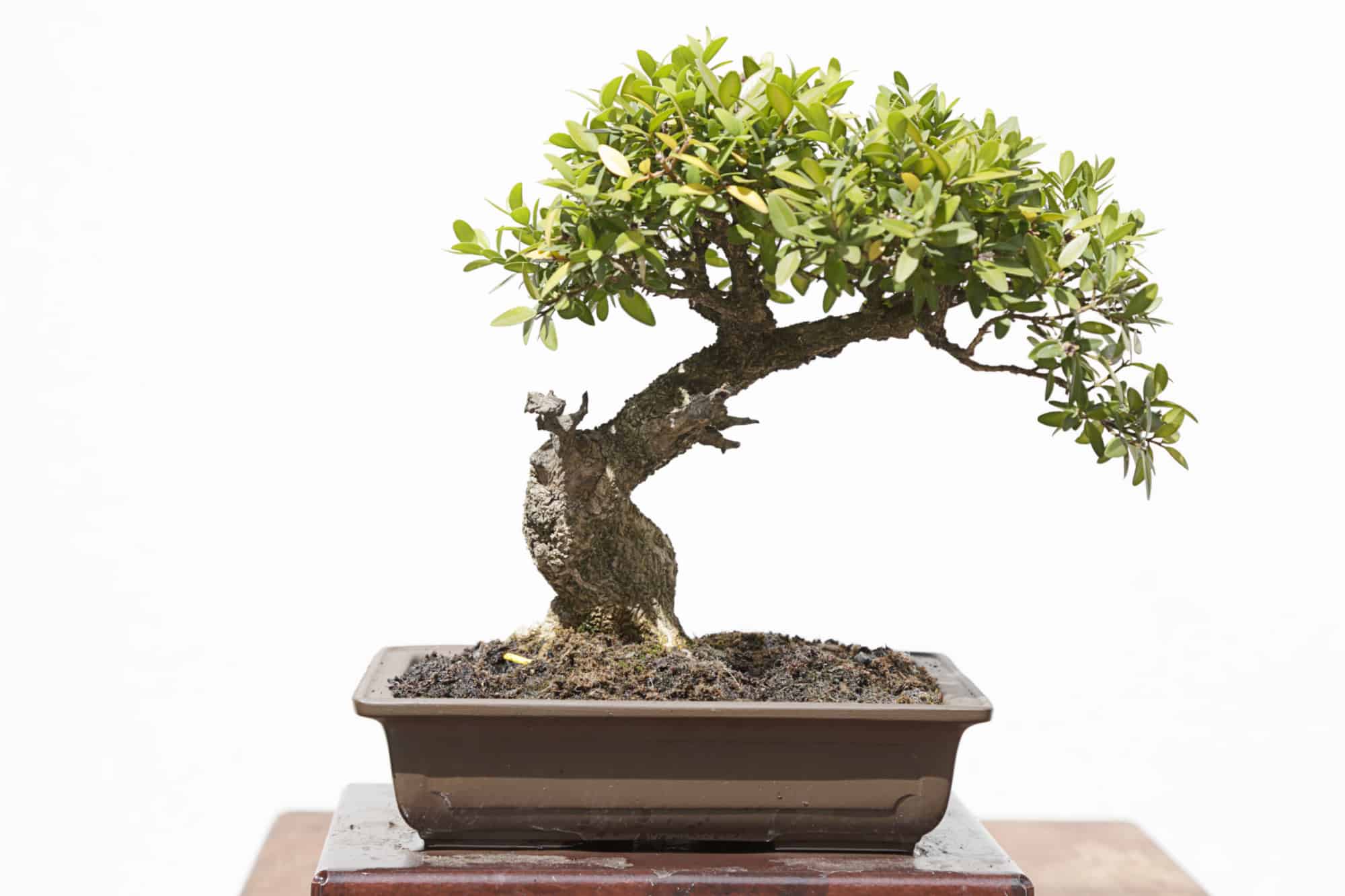Boxwood plants have been around for thousands of years and were planted by ancient Egyptians, Greeks, and Romans. One reason they have been around for so long is that they are relatively easy to take care of. This also makes boxwood plants perfect for Bonsai trees, especially for beginners. But what are the different kinds of boxwood plants that can be grown as Bonsai trees? How do you take care of them?
Here is all that you need to know about caring for a boxwood Bonsai tree!
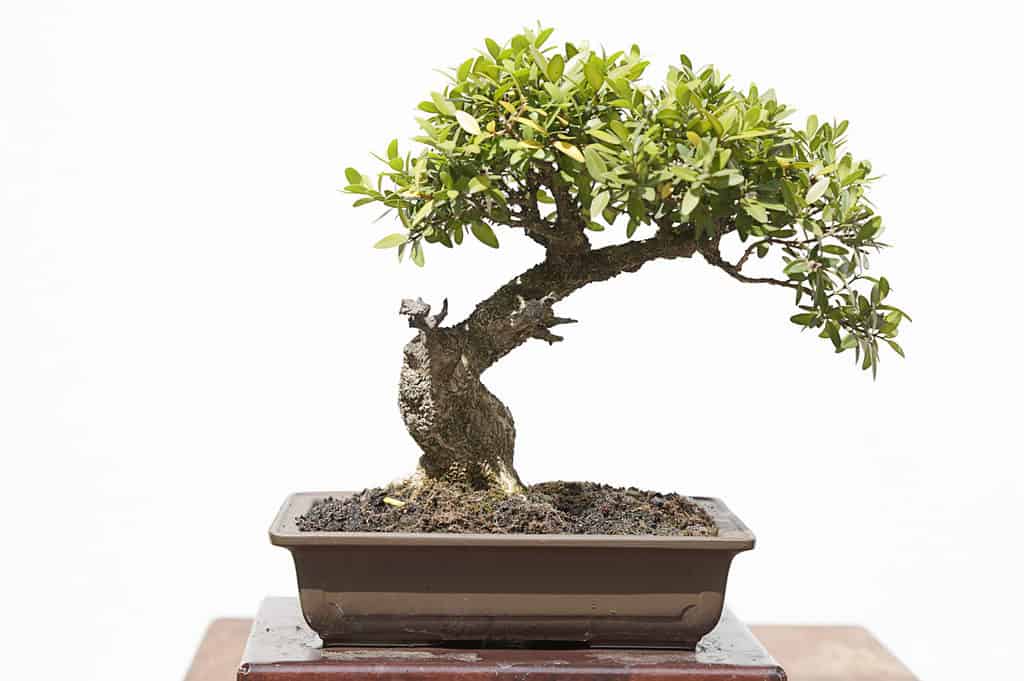
Pruning a boxwood Bonsai tree is easier than pruning other tree types.
©Raquel Pedrosa/Shutterstock.com
| Boxwood Bonsai Tree Facts | |
|---|---|
| Botanical Name | Buxus |
| Common Types | English boxwood, American boxwood, dee runk boxwood, fastigiata boxwood, Vardar valley boxwood, Japanese boxwood, green beauty boxwood, Korean boxwood |
| Sunlight | Full sun to partial shade. With certain types of boxwood plants, be mindful of leaf scorching when kept beneath direct sunlight. |
| Soil | Boxwood plants are largely adaptable to their soil needs. Normal Bonsai tree soil mixture should work just fine! |
| Water | Consistently moist, but well-drained. During the summer boxwood plants need more water than usual. Can tolerate brief periods of drought. |
| For Beginners? | Beginner to intermediate. Caring for a boxwood Bonsai tree can be easier than others! |
| Indoors or Outdoors? | Outdoors during warmer months or in warmer environments. Bring them indoors in the winter to protect them from frost and freezing temperatures. |
| Pairs Well With… | Rocks, moss, and other natural ornaments! |
Common Types of Boxwood Bonsai Trees
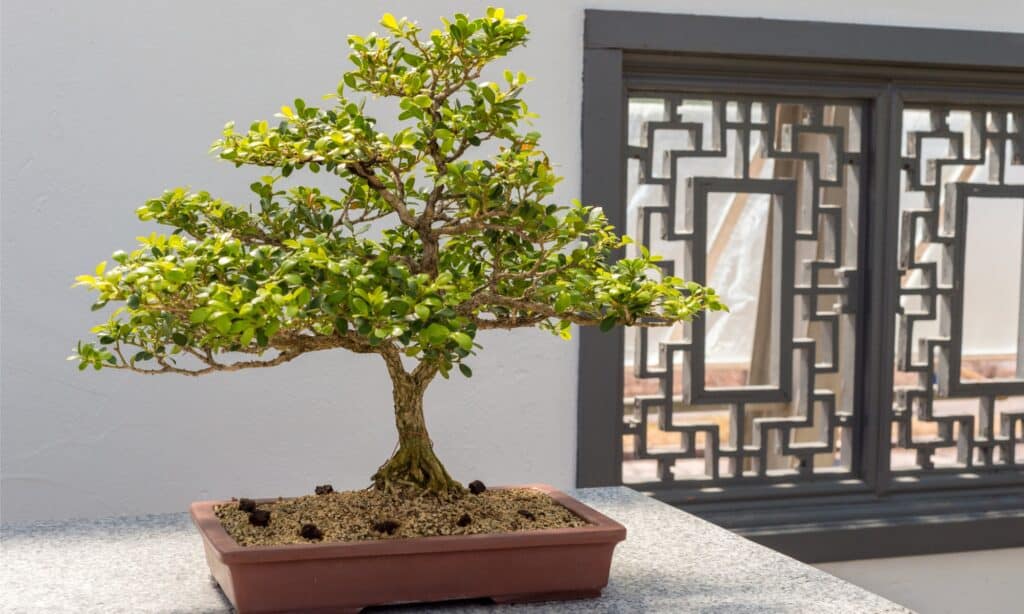
English boxwoods are not evergreen, even though other boxwood varieties are.
©iStock.com/MarcBruxelle
There are around seventy different types of boxwood plants. For the most part, each of them is suited for Bonsai tree art. Here are the most common types of boxwood Bonsai trees!
English Boxwood
English boxwoods are said to have originated thousands of years ago. They were planted by the ancient Egyptians, Greeks, and Romans. The English boxwood grows at a slow rate and prefers full to partial sunlight, well-drained soil. It has shallow roots that must be protected from hot temperatures. This is easy enough to do; simply put a layer of mulch made for gardens around the roots of the bush. Be careful to not pile the mulch too high however, as this can attract insects and other pests.
English boxwoods are not evergreen, even though other boxwood varieties are. In the winter, the leaves on these shrubs turn from green to red-brown to yellow. This can be prevented by spraying what is known as an anti-desiccant spray directly onto the plant. You’ll want to do this in November and then again in January.
American Boxwood
American boxwoods can grow tall and wide when planted naturally. On average, they grow up to 10 feet, though some have been known to grow to 20 feet with the proper care. These shrubs are hardy and can withstand cold temperatures. They are also resistant to disease and drought, making them fairly low maintenance.
The leaves on an American boxwood stay a vibrant dark green throughout the winter. They can grow beneath full sun as well as partial shade, and they prefer moist, well-draining soil.
Dee Runk Boxwood
Dee Runk boxwoods are fast-growing, evergreen shrubs. They grow vertically and can generally reach 10 to 12 feet in height. Though they grow best in partial shade, these plants can grow beneath full sun too. They need moist, well-draining soil. Dee Runk boxwoods are drought tolerant, but it is best to still water them as regularly as possible.
Fastigiata Boxwood
Fastigiata boxwoods are evergreen shrubs. They grow at a moderate to fast rate, for up to 6 inches a year. They prefer full sun to partial shade, though be careful exposing these boxwoods to full sun constantly. Their leaves could scorch and will most likely bronze during the winter months if left beneath direct sunlight for too long.
Fastigiata boxwoods prefer moist, well-draining soil that is loamy. These boxwoods are found in rocky areas as well as in forests. they are native throughout southern Europe, northern Africa, and western Asia.
Vardar Valley Boxwood
Vardar valley boxwoods can often be found growing in rocky areas as well as in forests. They prefer moist, acidic, loamy soil to grow properly. They also prefer full sun to partial shade, though be careful exposing these boxwoods to full sun constantly. Their leaves could scorch and will most likely bronze during the winter months if left beneath direct sunlight for too long.
These boxwoods are also native throughout southern Europe, northern Africa, and western Asia.
Japanese Boxwood
Japanese boxwoods are evergreen shrubs. They are native to Japan but can also be found throughout Asia. They prefer well-drained, acidic soil and do well beneath full sun and partial shade. Though slow-growing, Japanese boxwood is known for its hardiness. These shrubs stay green for most of the year. They bloom in late spring.
Green Beauty Boxwood
Green beauty boxwoods stay green even throughout the heat of summer and become bronzed in the winter months. They can grow in both partial shade and full sun, though they do best with more sun. These boxwoods grow moderately and prefer well-drained soil that is either neutral or slightly acidic.
Korean Boxwood
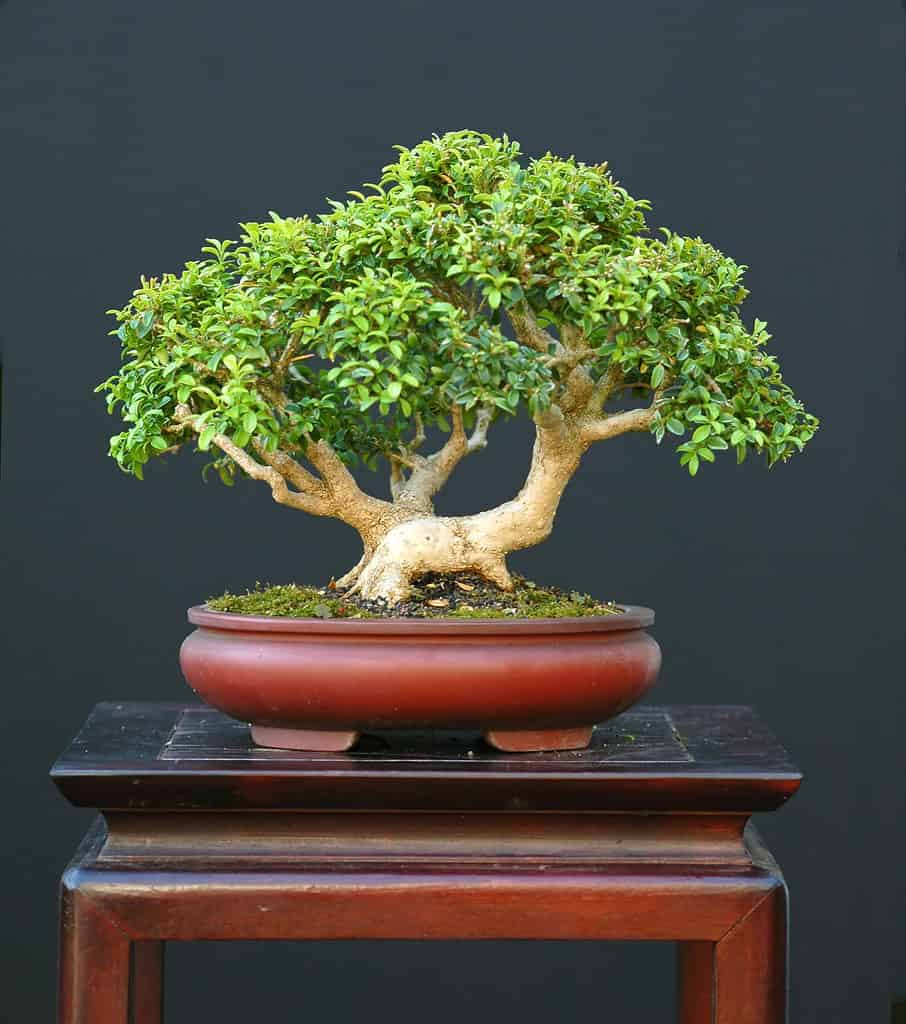
With small leaves, Korean boxwood Bonsai trees are delicate and intricate.
©Walter Pall/Shutterstock.com
Korean boxwoods are native to Korea, though they can be found throughout Asia. As they grow, these boxwoods are wider than they are taller, as they only reach about 2-3 feet in height. They are not evergreen, unlike most other boxwoods. During the summer, their leaves manage to stay a vibrant dark green color. But through the winter, these leaves turn to a bronze color.
In the spring, they blossom. These blossoms are light-colored and produce a pleasant scent. The Korean boxwood is extremely hardy and can endure extremely cold temperatures and weather. These shrubs prefer partial shade and loamy, wet soil.
Caring for Your Boxwood Bonsai Tree
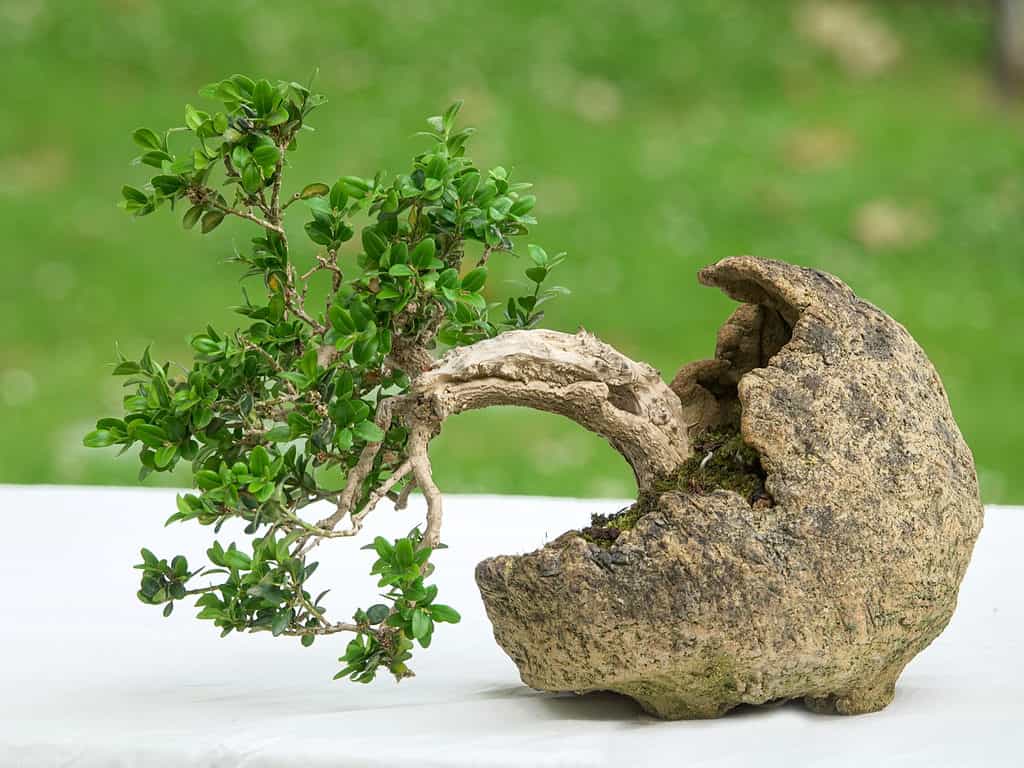
You can grow boxwood Bonsai trees out of rocks and old branches.
©irinacapel/Shutterstock.com
Caring for a boxwood Bonsai tree can be easier than caring for certain other plants. Growing them as Bonsai trees doesn’t change this, fortunately! Especially since boxwood trees take well to pruning. When they are grown naturally, they are often subject to pruning in gardens. This makes a boxwood plant perfect for a Bonsai tree!
Here are some more guidelines for taking care of a boxwood Bonsai tree!
Sunlight
As a whole most boxwoods can thrive beneath full sun as well as partial shade. Most of them, though, are susceptible to bronzing in the winter if they are often beneath direct sunlight. Their leaves can also be scorched. To prevent this, it is a good idea to move your boxwood every so often. Especially in the afternoon, to keep it away from the hot sun.
Soil Type
Soil largely depends on what specific type of boxwood you have. Though, for the most part, most boxwoods prefer moist soil that is well-drained. Some of them have more specific requirements. For instance, Japanese boxwood needs acidic soil. Vardar valley boxwood needs loamy soil. When selecting a Bonsai tree soil mixture for your boxwood Bonsai tree, keep this in mind!
Water
During the heat of the summer months, boxwoods need more water than usual. They can endure brief stretches of drought, however.
Placement
Figuring out how and where to place your Bonsai tree can be difficult. For the most part, boxwood Bonsai trees make it easy!
Since most boxwoods can have their leaves scorched beneath full, direct sunlight, you’ll want to place your boxwood where it won’t be beneath such sunlight all the time. During the winter, it is best to bring boxwood Bonsai trees inside to protect them from the cold. Some varieties, though, are very hardy and can withstand freezing temperatures.
Pruning Your Boxwood Bonsai Tree
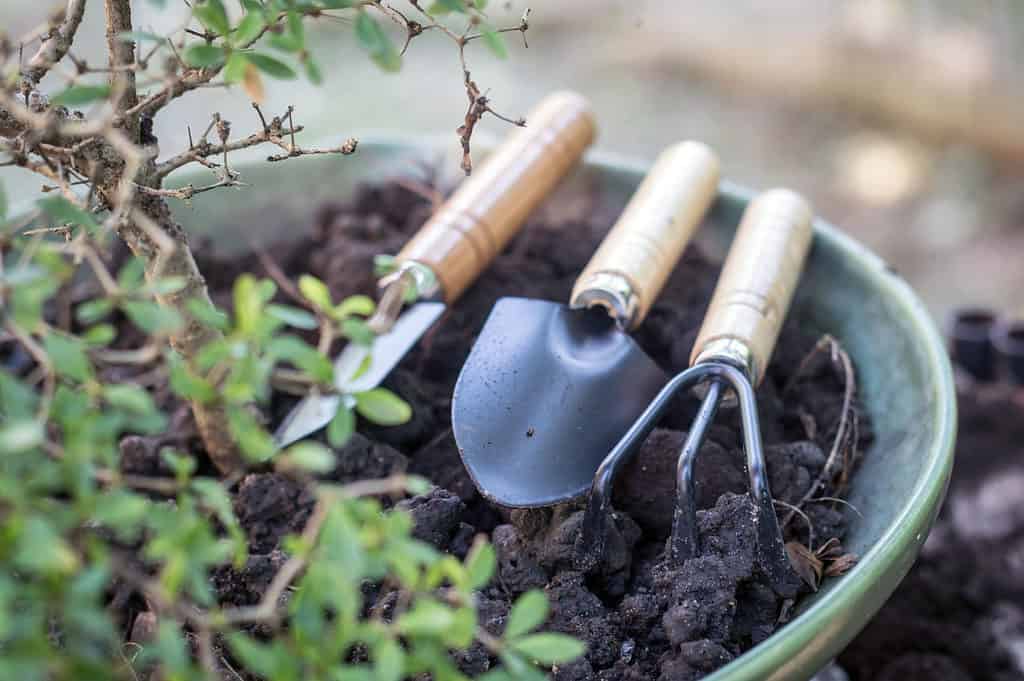
During the winter, it is best to bring boxwood Bonsai trees inside to protect them from the cold.
©wonderisland/Shutterstock.com
For the most part, most boxwood trees can endure a heavy amount of pruning. They are often pruned when they are planted naturally, such as in gardens and yards.
When new branches appear, trim them down to only one or two pairs of leaves or buds. Sometimes on boxwood Bonsai trees, the canopy can become too thick. This makes it difficult for light to come through. If your boxwood Bonsai tree reaches this point, it is best to prune these leaves back as soon as possible.
Ideal Boxwood Bonsai Tree Styles
Most boxwood Bonsai trees can be styled in a number of ways. The most popular style seems to be Hokidachi. This style is also known as the broom style and suits boxwood plants because they have many smaller branches. Another popular style for boxwood Bonsai trees is Kabudachi. Again, boxwood Bonsai trees are suited to this particular style because it highlights trees with multiple, smaller branches.
Propagating Your Boxwood Bonsai Tree

Sometimes on boxwood Bonsai trees, the canopy can become too thick.
©Structured Vision/Shutterstock.com
Boxwood Bonsai trees are best propagated through cuttings and air layering. Air layering is pretty simple to do. All you need is some moist sphagnum moss. You wrap it around a part of the stem or branch that is wounded, either naturally or purposefully. The moss can be fastened to the stem or branch with plant twine. The next step is to cover the entire area with plastic wrap. This preserves the moisture from the moss. Once roots begin to grow, simply remove your new plant and replant it normally!
Propagation of a boxwood plant is best done during springtime.
Common Problems with Boxwood Bonsai Trees
There are many diseases that the common boxwood can fall victim to. These can include scale, boxwood mites, nematodes, and certain fungal diseases. They can be bothered by pests and insects, but most insecticides will clear these problems right up.
Thank you for reading! Have some feedback for us? Contact the AZ Animals editorial team.

